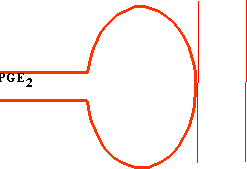
Non-Respiratory Functions of the Lung
I. Defense of the lung. 70m2 exposed surface area. Approximately 10,000 liters/day of air enters the alveoli. Aspiration is also a problem.
A. Olfaction - olfactory receptors in posterior nasal cavity, not in trachea, bronchi, or alveoli. Can sniff to attempt to detect potentially dangerous gases. This rapid shallow inspiration brings gases in contact with olfactory sensors without bringing them into the lung.
B. "Air conditioning" - the mucosa of the nose, mouth and pharynx has a large surface area and a rich blood supply that humidifies and heats or cools inspired gases. Surface area of nasal turbinates is approximately 160cm2 (Levitzky Fig. 10-1).
C. Filtration and cleansing mechanisms:
1. Filtration
a. Hairs at the inlet filter large particles (particles greater than 10-15 microns in diameter).
b. Contours of the nasal turbinates force inspired air to pass in numerous narrow streams so that solid particles pass close to either the nasal septum or mucosa of the turbinates. Particles simply impinge directly on mucosa or settle by gravity. Particles greater than 10µ are almost completely removed in the nose, along with some smaller ones.
c. Particles between 2 - 10µ usually settle on the mucus-lined walls of the trachea, bronchi, and bronchioles.
d. Particles between 0.3 and 2.0µ and all foreign gases reach the alveolar ducts and alveoli.
e. Particles less than 0.3µ in diameter usually remain as aerosols and are almost entirely expired.
f. Particles removed may include: silica, asbestos, inert dust, bacteria, and toxic gases.
2. Removal of filtered particles:
a. Sneeze or cough: deep inspiration, followed by a forced expiration against a closed glottis and vocal cords then abrupt opening of glottis and vocal cords. Results in explosive expelling of air --very high flow rates.
b. Cilia (Levitzky Fig. 10-2). - line entire respiratory tract (except part of pharynx, anterior 1/3 of nose, and the terminal respiratory units). Beating appears to be coordinated such that the sheet of mucus (containing trapped foreign particles) secreted by goblet cells and mucous glands is propelled toward the pharynx where is it swallowed or expectorated (Levitzky Fig. 10-3). Mechanism of control is not well understood. Nerves do not appear to be involved. Inhaled irritants may slow down or "paralyze" cilia.
c. Must suction the airways of patients unable to cough or clear the airways.
D. Defense mechanisms of the terminal respiratory units
1. Alveolar macrophages - large mononuclear ameboid cells - scavenge the alveolar surface (Levitzky Fig. 10-4). Contain lysosomes capable of killing bacteria. Engulf inhaled particles. Many other functions, including secretion of components of immune and inflammatory responses such as cytokines, arachidonic acid derivatives, enzymes, and growth factors. Appear to emigrate to the sheet of mucus on the walls of terminal bronchioles and "ride" up to larger airways (Levitzky Fig. 10-5).
2. Other particles may be removed by reaching the mucus sheets by upward movement of the alveolar fluid lining ; penetration into the interstitial space for phagocytosis by tissue histiocytes, and/or entrance into the lymphatic channels. Particles may also be destroyed by surface enzymes or removed by immunologic reactions.
E. Reflexes from the upper and lower respiratory tracts: cough, sneeze, bronchoconstriction, etc.
F. Overview of pulmonary defense mechanisms (Levitzky Table 10-1).
II. Non-respiratory functions of the pulmonary circulation.
A. Reservoir for left ventricle. Contains about 500 ml. blood.
B. Filter to protect the systemic circulation: traps particles that enter mixed venous blood as a result of natural processes, trauma, or therapeutic measures.
1. More pulmonary capillaries than are necessary for gas exchange in normal resting man.
2. Particles filtered include: small fibrin or blood clots, fat cells, bone marrow, detached cancer cells, gas bubbles, agglutinated RBC's (esp. sickled), masses of platelets or WBC's, debris in stored blood, and particles in i.v. solutions.
3. Decrease in diffusing capacity is usually transient (e.g. 4-5 days). Mechanisms for particle removal include lytic enzymes and macrophages.
4. Must filter blood of patients on cardiopulmonary bypass.
C. Fluid exchange and drug absorption.
III. Metabolic functions of the lung.
A. Uptake or conversion by lungs of chemical substances in mixed venous blood (Levitzky Table 10-2).
B. Formation of chemical substances in lungs and release for local use.
1. Pulmonary surfactant - formed in Type II alveolar cells (Levitzky Fig. 10-6).
2. Release of histamine and serotonin from mast cells in response to pulmonary embolism and anaphylaxis - cause bronchoconstriction and may initiate cardiopulmonary reflexes.
C. Release into blood of substances stored in pulmonary tissues or cells: bradykinin,
histamine, serotonin , PGE2, PGF2![]() , heparin and many other substances are all stored in the lung and may be released.
See roles of alveolar macrophages above.
, heparin and many other substances are all stored in the lung and may be released.
See roles of alveolar macrophages above.
Copyright 2000 M. G. LEVITZKY
Last updated Wednesday July 24, 2013 4:47 PM
LSUHSC is an equal opportunity educator and employer.
The statements found on this page are for informational purposes only. While every effort is made to ensure that this information is up-to-date and accurate, for official information please consult a printed University publication.
The views and opinions expressed in this page are strictly those of the page author. The contents of this page are not reviewed or approved by LSUHSC.
This page is maintained by webmaster-arc: mgiaim@lsuhsc.edu
